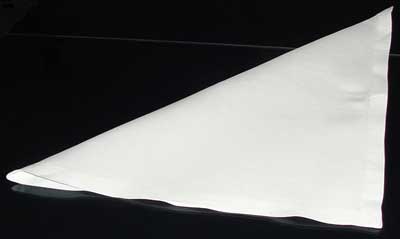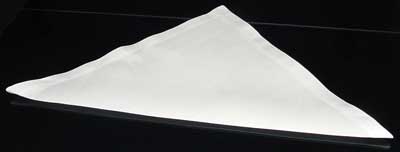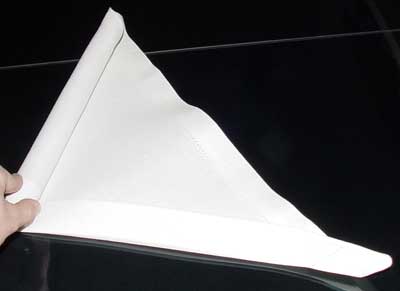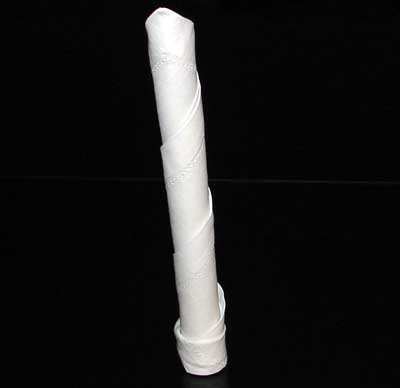NAPKIN FOLDING (PEACOCK)
Wednesday, July 24, 2013
Sunday, July 14, 2013
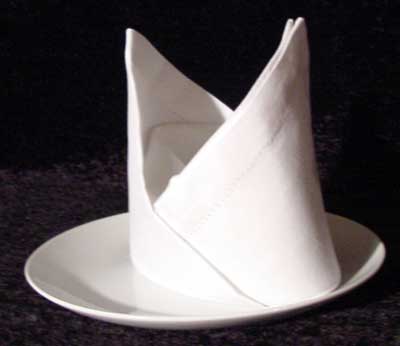 | The Bishop's napkin fold
this is a classic dinner napkin fold, but it can be difficult to line up the corners in the cap. some starch and an iron make it easier to be precise while folding this one.
|
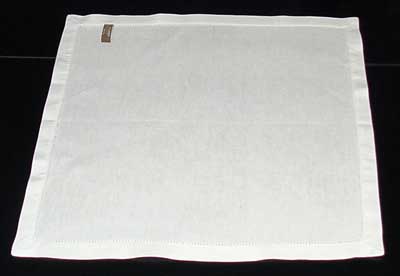 | 1.lay the napkin face down in front of you. |
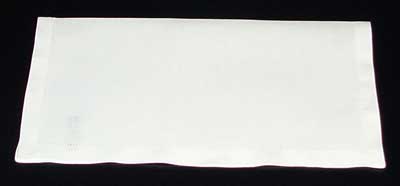 | 2. fold the dinner napkin in half so that the open ends towards you. |
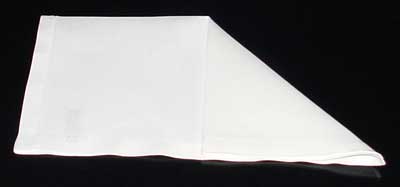 | 3. fold the far-right corner diagonally toward you ,resting the point in the center of the side closest to you. |
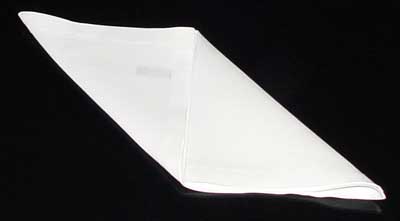 | 4. fold the near-left corner diagonally away from you ,resting it so that it lays right next to the previous fold. |
 | 5. flip the napkin over and orient it so it points to the far-left and to the near-right. |
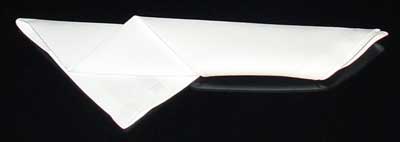 | 6. fold the bottom half of the napkin up and away from you ,laying it so the far edges run on top of one other. |
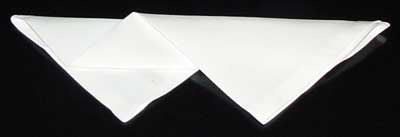 | 7. reach underneath of the napkin and pull out the flap on the right,making the near-side come to two points as seen in the picture. |
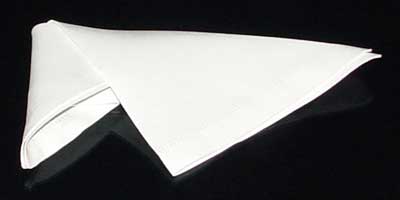 | 8. gently roll the left half of the left triangle over and tuck it's end underneaththe right triangle. |
 | 9. flip the napkin over,points pointing away from you. |
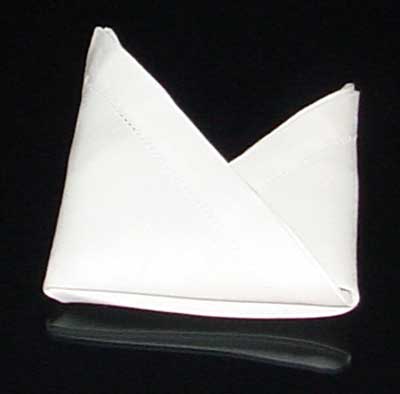 | 10 . fold the right triangle to the left,tucking it's end into the other triangle. |
 | 11. open the hat and press the material inside down to fill it out so that it becomes circular,this may take a little fidgeting. |
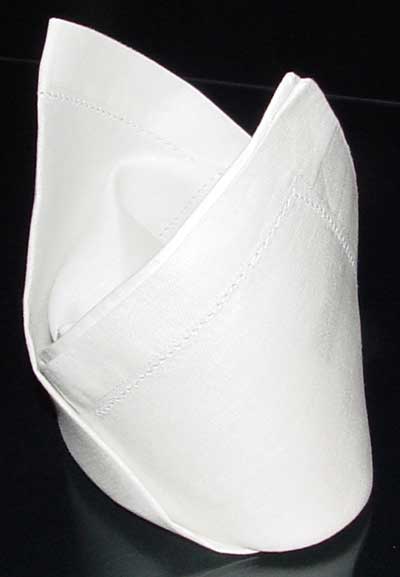 | 12. done. |
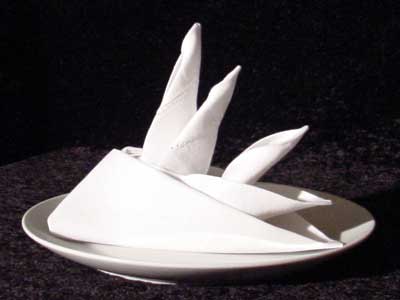 | The bird of paradise napkin fold |
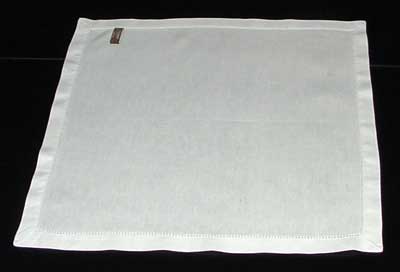 | 1. lay the napkin face down in front of you. |
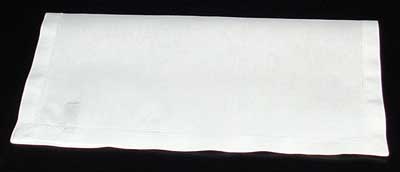 | 2. Fold the napkin in half. |
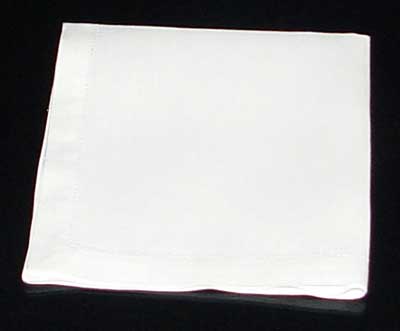 | 3. fold the napkin in quarters. |
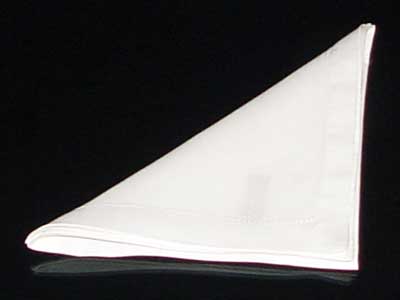 | 4. fold then napkin in half diagonally . |
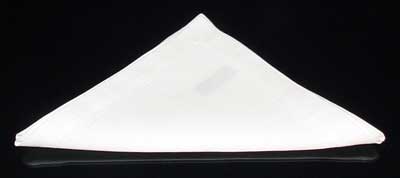 | 5. orient the triangle so the open tips is facing away from you. |
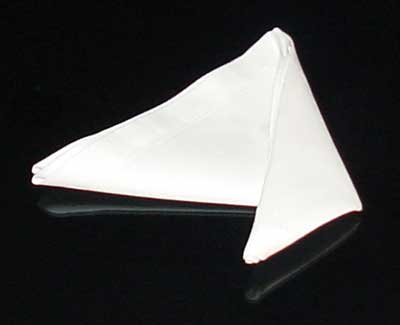 | 6. fold the right corner diagonally toward you.laying it down along the center line of the triangle,making a tip pointing towards you.an iron can make this important fold a whole lot easier. |
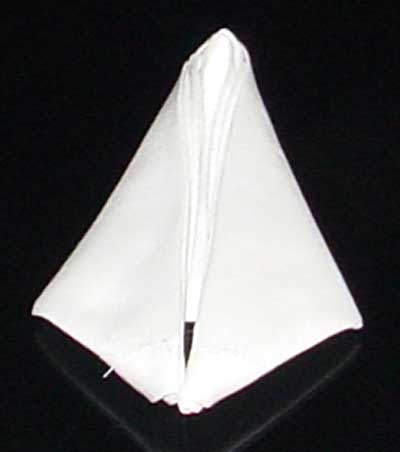 | 7. do the same with the left corner ,fold it diagonally toward you and press it down next to the previous fold. |
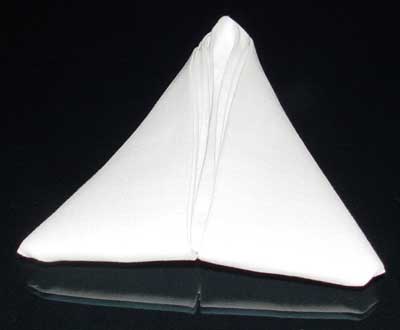 | 8. fold the two "wings" that you just made in folds 6 and 7 under so that you have your original triangle shape back. |
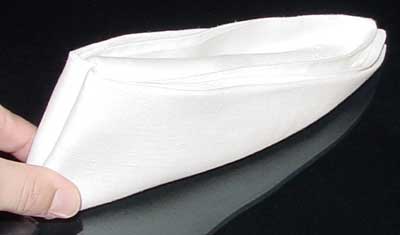 | 9. fold the triangle in half by bringing the center seam towards you and allowing the ends to fall. |
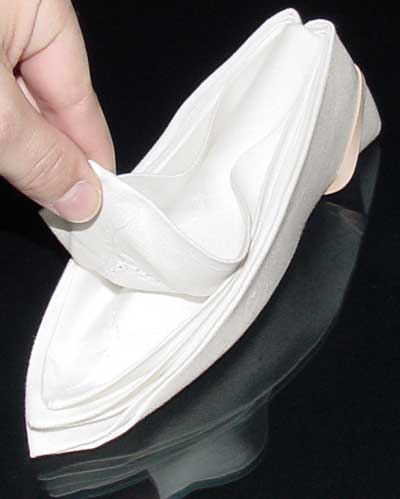 | 10. while holding the base firmly to keep your folds together ,pull up the four 'flaps' created by the napkin's corners. |
 | the pyramid napkin fold |
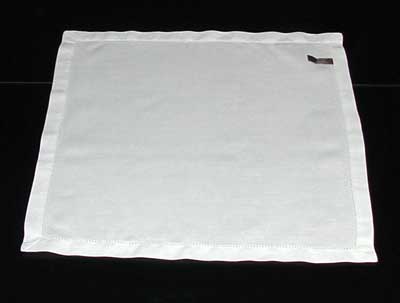 | 1. lay the napkin face down in front of you. |
 | 2. fold the napkin in half diagonally . |
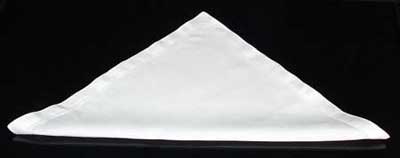 | 3. rotate the napkin so the open ends faces away from you. |
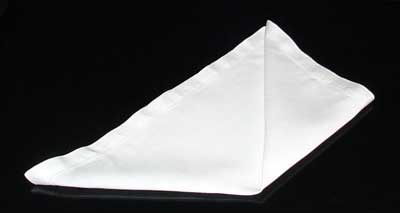 | 4. fold the right end up to meet the far corner,ensuring the edge of this new fold lays on the center line as shown. |
 | 5. repeat the last step with the left side,folding the left tip up to the far corner,creating a diamond shape with a seam running down the center. |
 | 6. turn the napkin over,keeping the open end facing away from you. |
 | 7. fold the napkin in half by bringing the farthest point of the diamond up and back to the nearest point. |
 | 8. turn the napkin over again,this time keeping the open end facing towards you. |
 | 9. fold the napkin along the center seam and you have a neat,sturdy pyramid. if your napkin won't stand neathly then you may need a little starch. |
Wednesday, July 10, 2013
Types of Crockery
Tableware
-Tableware is the dishes or dishware used for setting a table,serving food and for dining.
-Tableware is the dishes or dishware used for setting a table,serving food and for dining.
Meaning of crocery
-tableware can be meant to include cutlery and glassware.the nature,variety and number of objects varies from culture to culture religions and cuisines.
Dinnerware
-dishes are usually made of ceramic materials such as earthenware,stoneware,bone china or porcelain.however can be made of other materials such as wood,pewter,silver,gold,glass,acrylic and plastic.
Bowls
-soup bowls,cereal bowls,pasta bowls,fruit bowls or dessert bowls
Plates
-dinner plates, lunch plates, dessert plates, salad plates or side plates
-including teacup saucers, coffee cup saucers, demitasse saucers, and cream soup saucers.
serving dishes
butter dishes
casseroles,ramekins or lidded serving bowls
comoptes
pitchers or jugs
platters including chop plates,salvers and trays
salt and pepper shakers, salt cellars
- Sauce boats, gravy boat or small pitcher
- Serving bowls including vegetable bowls and salad bowls
- Sugar bowl and creamer
- Teapot, coffee pot
- Tureen
- Tajine
Drinkware
-Mugs, coffee or tea mugs, and
chocolate mugs.-Wine glasses, port glasses, beer glasses, brandy glasses, aperitif and liqueur glasses
-Water glasses, juice glasses, teacups, coffee cups, and demitasse cups
BOWL
- A bowl is
a round, open-top container used in many cultures to serve food, and is also used
for drinking and
storing other items.
- They are typically small and shallow, although
some, such as punch bowls and salad bowls, are larger
and often intended to serve many people.
PLATE
- A plate is
a broad, concave, but mainly flat vessel on which food can be served.
- A plate can also be used for ceremonial or
decorative purposes.
Shape
- A plate is composed
of:
- The well, the bottom of the plate,
where food is placed.
- The lip, the outer edge of the plate
(sometimes falsely called rim. It can be flat (like a pizza plate); or
inverted (slanting down); or everted (more common, slanting up)
- The rim, which is actually the lip
seen in profile - the opening of the vessel; sometimes with a gilded line.
- The base, which is sometimes used
interchangeably with 'well', but actually refers to the underside.
Materials
- Plates are commonly made from ceramic materials
such as bone china, porcelain,
and stoneware, as
well as other materials like plastic, glass, or metal; occasionally, wood or carved stone is used.
Size and Types
- Plates for serving food come in a variety of
sizes and types, such as:
- Saucer -
a small plate with an indentation for a cup
- Appetizer, dessert, salad plate,
and side plates - vary in size from 4 to 9 inches
- Bread and butter plate
- small (about 6-7 inches) for individual servings
- Dinner
plates - large (10-12 inches), including buffet plates which
tend to be larger (11-14 inches)
- Platters -
over sized dishes from which food for several people may be distributed at
table
- Decorative
plates - for display rather than used for food. Commemorative plates have
designs reflecting a particular theme.
- Charger -
a decorative plate placed under a separate plate used to hold food, larger
(13-14 inches)
Plates can be any shape, but almost all have a rim to prevent food from
falling off the edge. They are often white or off-white, but can be any color,
including patterns and artistic designs. Many are sold in sets of identical
plates, so everyone at a table can have matching tableware. Styles include:
- Round -
the most common shape, especially for dinner plates and saucers
- Square
- more common in Asian traditions like sushi plates
or bento, and to add modern style.
- Coupe -
a round dish with a smooth, round, steep curve up to the rim (as opposed
to rims that curve up then flatten out)
- Food-themed
artwork is common
PLATTER (DISHWARE)
- A platter is a large type of dishware used
for serving food.
- It is a tray on which food is displayed
and served to people.
- Its shape can be oval, round, rectangular, or
square. It can be made of metal, ceramic, or plastic.
- Plain and ornate platters suitable for more
formal settings or occasions are made of, or plated with, silver, and
antique examples are considered quite valuable.
- Especially expensive and ceremonial platters
have been made of gold.
SAUCER
- A saucer is
a type of small dishware.
- currently the term is used to denote a
small plate or shallow bowl that supports a cup –
usually one used to serve coffee or tea (see teacup).
- The center of the saucer often contains a
depression sized to fit a mating cup; this depression is sometimes raised, and
antique saucers may omit it altogether.
- The saucer is useful for protecting surfaces
from possible damage due to the heat of a cup, and to catch overflow, splashes,
and drips from the cup, thus protecting both table linen and the user sitting
in a free-standing chair who holds both cup and saucer.
- The saucer also provides a convenient place for
a damp spoon, as
might be used to stir the drink in the cup in order to mix sweeteners or
creamers into tea or coffee.
- Although often part of a place setting in
a dinner set, teacups with
unique styling are often sold with matching saucers, sometimes alone, or as part
of a tea set,
including a teapot and
small dessert plates.
- A set of four is typical for a tea set. Some
people also drink their tea out of saucers to cool it down.
Sunday, July 7, 2013
Types of Chinaware
COMMON TYPES OF MATERIAL FOR CHINAWARE:
Porcelain
The term porcelain lacks a universally agreed definition. It was first made in China; hence it’s commonly name china. Porcelain is generally divided into the three main categories of hard-paste, soft-paste and bone china, depending on the composition of the paste. Hard-paste Porcelain and Bone China are widely used in making dinner wares.
Hard-Paste Porcelain
Hard-paste porcelain consists of Kaolin, a type of clay, feldspar, and possibly other materials, is fired at about 1400 degrees Celsius to produce great hardness and strength. Hotel Line (or industrial line) made by most reputable producers with enhanced stability and durability are preferable for hotel use.
Bone China
Bone China is a mixture of porcelain and about 40 or 50 percent of ox bone ash. The bone ash serves to whiten and slightly strengthen the porcelain, while reducing the necessary firing temperature by about 150-200 degrees Celsius. Bone china is almost snow-white that gives a better presentation on tableware. Because it is also easier to make, harder to chip, and stronger than hard paste porcelain, bone china has gained popularity worldwide although European consumers continue to favor hard porcelain.
Stoneware/ Earthenware
Both Stoneware and earthenware are common ceramic materials. Stoneware is hard enough to resist scratching by a steel point. It is more opaque, and normally only partially vitrified. It is usually colored grey or brownish because of impurities in the clay used for its manufacture, and is normally glazed. Earthenware is less strong, less tough, and more porous than stoneware but it is lower cost. Due to its higher porosity, earthenware must usually be glazed in order to be watertight.
Stoneware/ Earthenware are generally used for more casual settings as accent pieces to enhance the authenticity of some cultural dishes.
17 Types Of Cutlery
Any sophisticated diner wants to be familiar with the tools that may or may not be offered to them at the table. Knowing them by sight will be very useful, but it's also important to know why they offer you that specific knife for your purposes so... let's become educated diners together, shall we?
1) Dinner Fork :
this is long tined fork you're used to. originally forks only had two tines. this worked beautifully for things like meat. however ,it doesn't work so well with peas or corn or such. more tines were added to make it easier to capture a variety of things from meat to legumes to vegetables.
2) salad fork :
3) fish fork and knife :
These will usually be silver.Fish is often served with lemon, which will react with steel and will
create an unpleasant taste. So, if you're going to bother to go all out and buy
the fish fork and knife set, make sure it's silver. As you may be able to tell,
the tines on a fish fork are shorter than a traditional meat fork.A salad fork is shorter too.As we know, the tines
on a salad fork are not evenly spaced. But a fish fork's tines are evenly
spaced. The knife will usually be your dead giveaway. It will be in the same
place in a place setting on the opposite side. These knives are not designed
for cutting, they're more supposed to be used for seperating the fish meat from
the bone cleanly. This knife is meant to be held the same way as the knife
you're more familiar with, so don't worry.
4) Seafood Fork :
These look like something Poseidan might yield. It can
either have two or three short tines and is usually built to a) follow the
shape of a shell and/or b) get into small spaces and spear the meat. This
is an extremely generic fork... keep in mind that there are lobster forks,
oyster forks, snail forks (I know it's not a seafood, but it is a shell food),
and shrimp forks.
5) Beef Fork :
A fork used specifically for picking up thin slices of
meat (as you can guess beef would qualify). It's shaped like a regular fork but
it's bigger and the tines are curved outward. You're not likely to see one any
time soon... but just in case.
6) Relish Fork :
6) Relish Fork :
This is
sometimes called a condiment fork. If you see it, it looks like a mini fork
with a long handle but... look carefully. There are two or three tines and
they're set very close together. Often, but not always, the ends of the tines
will be slightly splayed in order to hold more. All of this makes
sense when you think of what relish and chutney are. So why not use a spoon?
Don't be trashy! A relish fork allows for liquid to drain off which will make
less of a mess and keep whatever food the server is topping from getting soggy.
In a pinch, just use a seafood fork.
7) Teaspoon :
7) Teaspoon :
A small spoon (not the measuring spoon) that is
supposed to be used for... ready? ONLY BEVERAGES (though, actually, coffee does
have its own spoon). Yeah, the theory is that everything else served at the
table either has a seperate spoon or does not require one.
8) Tablespoon :
8) Tablespoon :
A large spoon that is nowadays, usually used for
serving rather than eating. So, naturally, the cutlery tablespoon holds
the equivalent of the measuring spoon tablespoon, right? Nope, actually
a cutlery tablespoon holds less than a tablespoon.
9) Soup Spoon :
9) Soup Spoon :
What? Really?
We have to go through soup spoons?! Yeah, of course. Quick! What's the
difference between a tablespoon and a soup spoon? See... ah, gotcha. Okay,
here's the thing. A tablespoon is oval-shaped. How 'bout a soup spoon? Well, of
course, because style is the name of the game, the shape will vary from set to
set. But if we're talking standard definitions, a soup spoon has a rounded bowl
rather than ovoid. It is also supposed to be slightly less than a tablespoon.
These, of course, are the definitions for a Western soup spoon. Chinese soup
spoons are usually made of ceramic and flat-bottomed.
10) Caviar Spoon :
Oh come on! A... why would... but... that's just
pretentious. It is, but if you're paying for good caviar, you want to do this
right. For starters these spoons usually look distinctive. To me, they look
like the Fischer-Price version of a spoon - sort of flattened, very round and
with a long handle (in proportion to the size of the bowl). These spoons
will often be made of glass, bone, mother of pearl and other non-metalic
materials. But why? Caviar comes in tins without absorbing the metalic taste.
If you had this thought, you'd be 100% right. You just want to make sure it's a
spoon with a non-reactive nature. Also, think of the caviar culture and compare
it to any other culture. The culture of smoking requires props... absinthe
drinkers... pot smokers... wine drinkers... they've all got their own props. So
don't judge caviar enthusiasts based on their spoon.
11) Dessert Spoon :
11) Dessert Spoon :
Horray!
Everyone knows dessert is best and, therefore, deserves its own spoon. It may
be difficult to tell a dessert spoon from a soup spoon. Traditionally, the
shape is ovoid (like a tablespoon) but the size is roughly the same size as a
soup spoon. Oh, wait... I know the easiest way to tell a dessert spoon... It
will almost always be placed above the plate (specifically so that it doesn't
get confused). Why on earth would the dessert spoon for a formal dinner be so
large, when desserts are typical small, delicate dishes? Well, piggie, the
spoon is not supposed to be put in the mouth. You're supposed to eat from the
side of the spoon.
12) Runcible Spoon :
12) Runcible Spoon :
If someone asks you if you want a runcible spoon...
they're being an ass. This is a nonesense spoon that does not exist and comes
from Lear's poem "The Owl and The Pussycat." Though, on the flipside,
if you want to make your dinners feel ignorant, apologize for not putting
runcible spoons on the table and see how they react.
13) Steak Knife :
13) Steak Knife :
A steak knife should be offered with any fibrous
protein. What I find more interesting is that you can tell the clientele of a
restaurant by their steak knives. How's that? Go to a middle of the road steak
house... Your steak knife will be over-sized (and if it's family oriented, the
tip will be rounded) with smaller serrations... A more upscale restaurant will
give you a smaller sharper knife with a pointed tip. Seriously, check it out
and tell me if I'm wrong.
14) Butter Knife :
14) Butter Knife :
Smaller than a
dinner knife or a steak knife and usually (but not always) with a rounded tip.
What should a person use this for? Well, to be proper, you should ONLY use it
to cut and spread butter.
15 Dinner Knife :
15 Dinner Knife :
16) Oyster Knife :
17) Cheese Knife :
Not a cheese
slicer, a cheese knife. This knife has the feel of an inverse knife,
thinner at the handle, wider at the end (to counteract the effect of how we
humans naturally hold a knife and allow us to cut through evenly) and has a
series of holes in it. Yeah, this isn't to mimic Swiss cheese... it's to keep
the cheese from sticking to the knife.
Subscribe to:
Comments (Atom)


